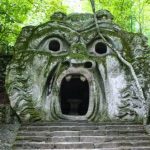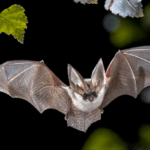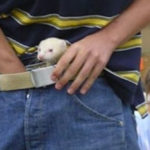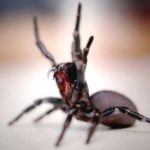 Mysteries
Mysteries  Mysteries
Mysteries  History
History 10 Surprising Stories About the Texas Rangers
 Humans
Humans 10 Philosophers Who Were Driven Mad by Their Own Theories
 Miscellaneous
Miscellaneous 10 Video-Game-Worthy Weapons and Armors from History
 Weird Stuff
Weird Stuff 10 Psychics Who Accurately Predicted Wartime Events
 The Arts
The Arts 10 Pieces of Art Inspired by a Broken Heart
 Health
Health 10 Science Fiction-Sounding New Medical Treatments
 History
History 10 Surprising Facts About the Father of Submarine Warfare
 Space
Space Ten Astonishing New Insights into Alien Worlds
 Weird Stuff
Weird Stuff 10 Bizarre Summer Solstice Rituals Still Practiced Today
 Mysteries
Mysteries Top 10 Haunting Facts About the Ghost Ship MV Alta
 History
History 10 Surprising Stories About the Texas Rangers
 Humans
Humans 10 Philosophers Who Were Driven Mad by Their Own Theories
Who's Behind Listverse?

Jamie Frater
Head Editor
Jamie founded Listverse due to an insatiable desire to share fascinating, obscure, and bizarre facts. He has been a guest speaker on numerous national radio and television stations and is a five time published author.
More About Us Miscellaneous
Miscellaneous 10 Video-Game-Worthy Weapons and Armors from History
 Weird Stuff
Weird Stuff 10 Psychics Who Accurately Predicted Wartime Events
 The Arts
The Arts 10 Pieces of Art Inspired by a Broken Heart
 Health
Health 10 Science Fiction-Sounding New Medical Treatments
 History
History 10 Surprising Facts About the Father of Submarine Warfare
 Space
Space Ten Astonishing New Insights into Alien Worlds
 Weird Stuff
Weird Stuff 10 Bizarre Summer Solstice Rituals Still Practiced Today
10 Surreal Cities Inhabited by Animals
Before 2007, more people lived in rural areas than in cities. Since then, humans have become more geographically concentrated, and many cities have grown in size as people have flocked to them. But some animal species have long lived in close quarters this way and for the same kinds of reasons that people do, such as being close to resources they need, for defense, and to co-operate or socialize with others.
Although trained architects and urban planners are absent, these animal “cities” are often impressive. Some are highly complex and have been built over generations; others make clever use of their surroundings, and the population of some of them dwarfs that of the biggest human cities. In no particular order, here are ten of the most amazing animal cities.
Related: 10 South American Animals That Get A Bad Rap
10 Eel City
Eel City leaves no mystery as to what slippery citizens can be found there, but what is strange is why there are no other places like it. It is found around 2,000 feet (609 meters) under the South Pacific around the summit of a recently formed volcano called Nafanua, just off the coast of American Samoa. Scientists on an expedition to see the volcano in 2005 were surprised to suddenly see hundreds—maybe even thousands—of eels scurrying in and out of its crevices.
Some of the scientists had experience exploring hydrothermal vents under the sea and said they had never seen or heard of anything like the eel city. Small eels are often spotted in the deep sea, but it is unusual for such a large group to be found together. And eels are not known to eat microbial mats, the only possible source of food the scientists could see around the volcano.[1]
9 Octlantis
A population of 15 might not sound like much of a city, but when those 15 are “gloomy” octopuses who were thought to be antisocial loners, it is actually quite remarkable. The researchers who found the Australian site named it Octlantis, not to be confused with the nearby city of Octopolis they found a few years earlier. While the residents of Octlantis were no longer living alone, they were still pretty antisocial. Scientists saw them fighting and even evicting each other from their hideouts.
It seems that 15 is a crowd, but two is still company, and the scientists did also see the octopuses mating and communicating. It is unclear what made the octopuses team up in the first place. They might have done so for defense, which would be an example of the creatures’ considerable intelligence, or it might simply be that the area has ample food but not much shelter.[2]
8 Underground Ant City
In 2012, a sophisticated yet mysteriously abandoned underground city was excavated by scientists. Its population once numbered in the millions, and it was ruled by a queen, with each citizen performing a specific role in society, from soldier to sanitation worker. They left behind a vast and complex network of highways, tunnels, waste pits, and gardens. Visitors who would like to see this historical marvel should head to Brazil, but they will have a tough time getting in. Why?
Because it was not built by people but by tiny leaf-cutter ants. For creatures of their size, the project is on a scale similar to the Great Wall of China. It covers an area of 500 square feet (46.5 square meters) and descends 26 feet (7.9 meters) below the ground’s surface. Although their colonies are usually much smaller and can even be as small as an acorn, the work probably did not put too much of a strain on the ants, which are super strong and can lift up to 50 times their own body weight.[3]
7 Ancient Termite Megalopolis
As impressive as a Great Wall-scale city built by ants is, it pales in comparison to the work of another tiny insect species. Termites are thought to have started working some 4,000 years ago on the 200 million mound megalopolis in northeastern Brazil. Despite this lengthy history, the site is still occupied and still under construction. The network of tunnels below the hill-shaped mounds, which are up to 10 feet )3 meters) tall, spans an area about the size of Great Britain, and the amount of soil the tiny mites have moved is the same as about 4,000 Great Pyramids of Giza.
Surprisingly, the area is hard to spot from the ground because it is surrounded by a semi-arid forest. However, it can be seen by satellite. The forest is the reason the termites took the trouble to dig the tunnel complex in the first place; they eat the dead leaves, and the tunnels help them emerge and escape safely when they need food.[4]
6 The Valley of Giants
Entering a large, deep cave in the middle of a forest, which has deep grooves in its walls that were almost certainly carved out by the claws of some colossal creature, is not a job for the faint of heart. Luckily for the paleontologists who discovered and explored a complex of six such caves in Minas Gerais, Brazil, the giant animals that used to occupy them went extinct about 10,000 years ago. The caves are actually paleo burrows, which means they were dug by animals, and the most likely culprits seem to be giant prehistoric ground sloths and armadillos.
Although some species of ground sloths could reach up to 20 feet (6 meters) tall when standing, the size of the burrows—up to 131 feet (40 meters) deep and 13 feet (4 meters) high—suggests they were dug by a colony rather than an individual. This is supported by a few small, smooth hollows which were dug into the wall of the last chamber of every burrow. It is possible that they were individual resting places for the occupants.[5]
5 Aerial Cities
Surprisingly, a “Sociable Weaver” is not, in fact, a member of a crochet club but an unusual species of bird found in South Africa and Namibia. It is said that birds of a feather flock together, and this is certainly the case for sociable weavers, who build enormous nests that resemble thatched roofs high in the treetops so they can live in large groups. One nest can comprise up to 95 separate chambers where families of the birds can make their homes.
The first person to write about them, in the late 18th century, described their style of nest as an “aerial city” and saw one that was so big he guessed that there must have been 800-1,000 birds living inside it. They really are sociable, too, as they even let other bird species, such as the pygmy falcon, use their nests for shelter and breeding.[6]
4 King Penguin City
St. Andrew’s Bay, on the icy island of South Georgia near the Antarctic, is home to one of the world’s largest penguin colonies. Around 400,000 king penguins gather on the island, which is an amazing number considering that within the last century, whalers had to abandon the island after bringing the wildlife there to the brink of extinction. Even more impressive is that the adult penguins, who leave for up to five months at a time to catch food, are actually able to navigate their way through the busy beach to find their own young.
While this penguin “city” does not contain shelters or tunnels, it is impressively organized, given the lack of leadership. Molting penguins are gathered together, as are the mischievous young chicks while their parents are away. Penguins who need to wash and bathe gather around natural pools in the bay, and long, less densely packed columns lead to the sea like highways.[7]
3 Prairie Dog Town
Nitpickers might point out that the groups in which black-tailed prairie dogs live are called “towns” and not “cities,” but the population of the largest recorded prairie dog town was far greater than that of any human town. In fact, it is far greater than the population of most countries. It was discovered in Texas in the early 20th century and spanned 250 x 100 miles (402 x 161 kilometers) with a population of 400 million prairie dogs.
That meant about 50% of the rodents estimated to live in Texas at the time lived in that one giant town. The 25,000-square-mile (64,750-square-kilometer) town has since been broken up by humans settling in the area and developing the land. This has caused the population of prairie dogs in Texas to decrease by more than 99% since that time. However, it is now relatively stable at around eight million.[8]
2 Monkey City
Something many animal cities share is distance from human settlements. However, abandoned buildings can sometimes serve the needs of animal colonies, and many do not remain empty for long. For example, the stunning, centuries-old ruins of the old city of Polonnaruwa, Sri Lanka, are now home to around 4,000 macaques. And this strange animal city has even done a sort of census, for the monkeys at the site were part of a large Smithsonian Institute study between 1968 and 2008.
Every single one that lived there was given its own name, with some being named after famous people and local leaders. They also earned a small amount of fame by starring in documentaries such as the Animal Planet film Dark Days in Monkey City. The Discovery Channel and the BBC were also among those who made shows about them.[9]
1 The Polar Bear Capital of the World
Some brave species live in cities not of their own design nor nature’s. Instead, they reside in human cities, and not just cities that have been abandoned. There is nothing unusual about rats, foxes, and pigeons coexisting with city-dwellers around the world, for example. But in Churchill, Canada, residents and visitors have to coexist with the world’s largest land carnivore, the polar bear, for a couple of months every year.
In the winter, when temperatures drop and the polar bears make their way to Hudson Bay to hunt seals, hundreds of them flock to the area around Churchill. Suddenly, it becomes the “Polar Bear Capital of the World.” Some effort is made to scare off the bears and steer them around the settlement, but it is still not unusual for some to slip through. Luckily, they are often spooked by encounters with people, and fatalities are rare.[10]








